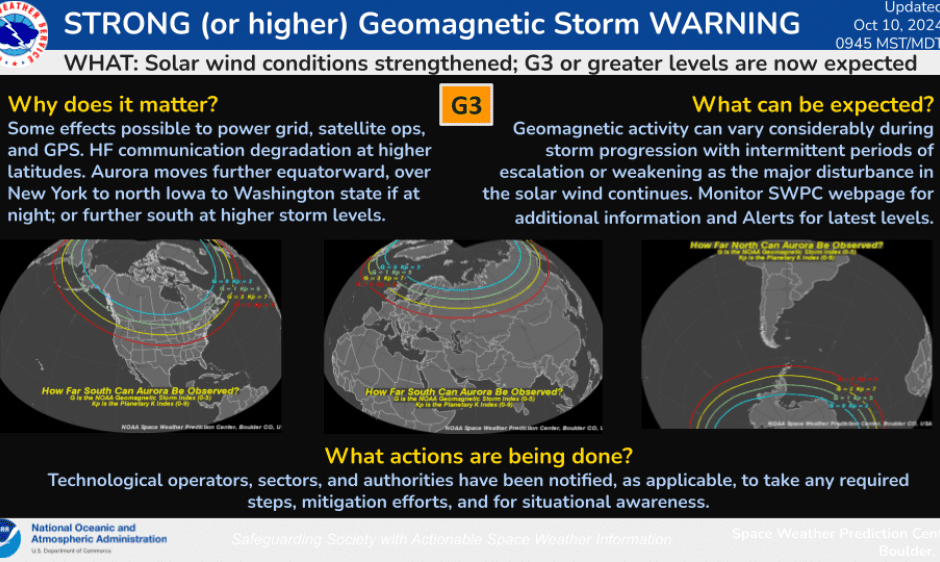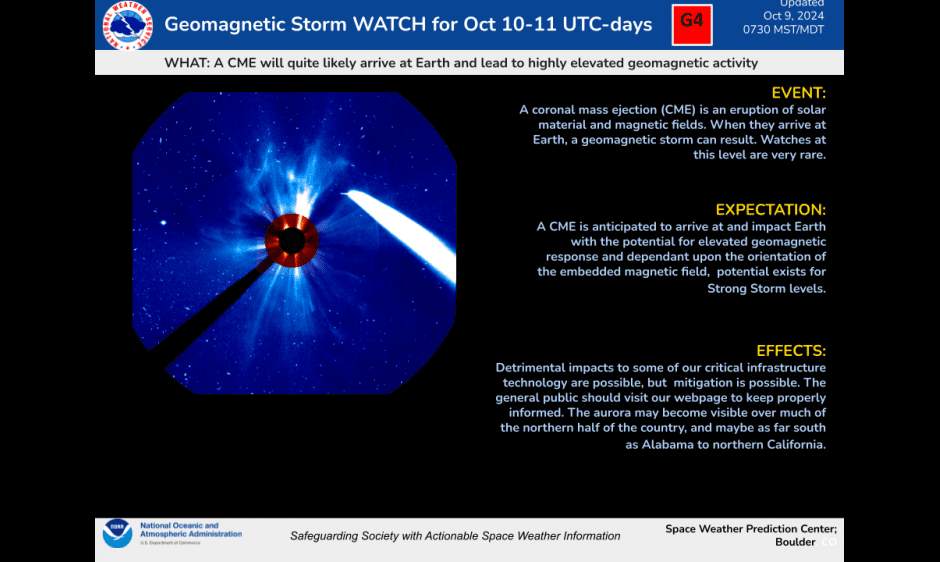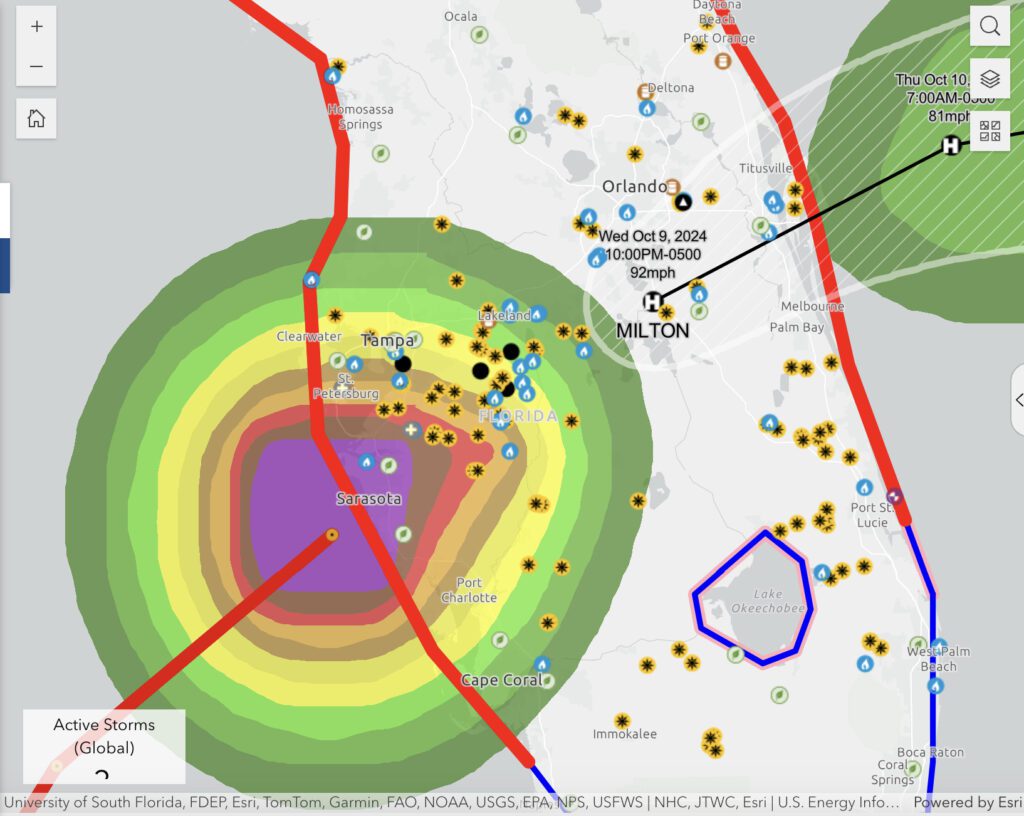Severe Solar Storm Threatens Power Grid Amid Hurricane Helene, Milton Recovery
UPDATED (Oct. 11): The National Oceanic and Atmospheric Administration (NOAA) has upgraded its G4-level “severe” geomagnetic storm watch to a G3-level “strong” geomagnetic storm warning after an anticipated coronal mass ejection (CME) arrived at Earth at 11:15 a.m. EST on Thursday, traveling at nearly 1.5 million miles per hour.
The G3-level warning is now in effect alongside the earlier G4 watch, which NOAA issued on Oct. 9 as a proactive measure, in part to prompt the North American power grid to prepare for the expected CME arrival between Thursday morning and midday. The solar storm’s disruptions to communications, navigation systems, and power infrastructure could cause new hurdles for regions already weakened by Hurricanes Helene and Milton, the agency warned.
NOAA measures the magnitude of geomagnetic storms using the K-index and, by extension, the Planetary K-index (Kp scale). Like hurricanes, tornadoes, and earthquakes, the scale conveys the severity of a geomagnetic storm event, with G5 being the most extreme and G1 being minor.
According to NOAA, the solar storm was triggered by a fast CME that erupted from the sun on Tuesday evening (Oct. 8). By Wednesday afternoon (Oct. 9), NOAA estimated the CME’s speed to be between 1,200 and 1,300 km/s. “There is potential to reach G4 (Severe) upon arrival of this CME and throughout its passage,” the agency predicted, adding, “We won’t know the characteristics of the CME until it reaches 1 million miles from Earth and its speed and magnetic intensity are measured by the DSCOVR and ACE satellites.”
As the CME arrived on Thursday morning (Oct. 10), NOAA continued to analyze its strength and structure to assess potential geomagnetic storm intensity. Initially, the agency expected G3 levels due to the CME’s magnitude and potential. “Therefore, a G3 or greater warning has been issued. G4 (Severe) levels remain likely with the watch still in effect, and there is even a slight chance of G5 (Extreme) levels based on initial observations of the CME’s strength. Updates will continue as conditions develop, with Alerts issued accordingly,” NOAA stated.
By 11:57 a.m. EST, NOAA confirmed observing G4 (Severe) geomagnetic storming levels. G4 levels could lead to “possible increased and more frequent voltage control problems—[which are] normally mitigable,” according to the agency. G4 conditions also raise the likelihood of satellite operation anomalies and longer periods of GPS degradation, it said. In an update at 6:37 p.m. EST, the agency reported that G4 (Severe) geomagnetic storm levels continued to be observed as the CME passage intensified. “Things are favorable for G4 (Severe) levels to potentially continue into the night hours, with a chance for G5 (Extreme) levels,” the agency noted.
So far, in response to a warning from the North American Electric Reliability Corporation (NERC), PJM has followed protocols and issued a warning that a possible geomagnetic disturbance (GMD) could affect its system until 2 a.m. on Oct. 11. However, as of Oct. 11, PJM extended the GMD Warning to 2 p.m. Friday, following an overnight increase in solar activity intensity. At 7:39 p.m. on Oct. 10, the grid operator also issued a less common GMD Action to protect the power system from potential disruptions caused by geomagnetically induced currents (GICs).
No significant impacts to grid operations have been experienced so far, though PJM is closely monitoring the situation and has implemented conservative power limits to safeguard the system. “While severe GMD warnings are not common, lower-level activity has resulted in GMD Alerts from PJM on 10 separate days in 2024, including a warning issued on Oct. 7. GMD Actions are even less common, with only two other instances in the last decade. One of those instances occurred on May 10 of this year, which reflects the period of higher solar activity that the sun is currently in,” PJM said.

A Fast-Approaching Solar Storm
“This is a very speedy CME—it’s the fastest CME that we’ve really measured that had a total Earth-directed component thus far,” said Shawn Dahl, service coordinator at NOAA’s Space Weather Prediction Center (SWPC), during a press briefing on Wednesday afternoon. “The solar wind is monitored with spacecraft 1 million miles from Earth for the arrival of CMEs. It is at this point that if the CME arrives and has a strong enough magnetic field and in a favorable orientation that we can determine the need for warnings and true geomagnetic storm intensity potential,” he said.
SWPC experts during the call suggested the CME is part of a significant uptick in geomagnetic storm activity it has monitored as part of the current solar cycle, Solar Cycle 25. Solar flares in May 2024 prompted the most intense solar storms in more than two decades, reaching G5 levels and causing widespread GPS disruptions and some stress to power grids.
Since the end of 2019, the ongoing cycle has already produced at least 50 X-class flares—major events that can trigger planet-wide radio blackouts and long-lasting radiation storms—with 46 of them occurring this year alone. SWPC suggested the current storm has the potential to reach similar levels. “We don’t try to do a G5 watch, so we call it a G4 or greater, because we do have a potential for a higher than G4. I think we’re calling it a 25% chance to reach a G5 level right now based on our forecast,” Dahl explained. However, unlike May, this storm features a single CME, rather than the compounded events seen earlier, which may result in a shorter-duration event, SWPC noted.

A Potential Double Whammy for Hurricane Recovery
The potential for solar storm disruptions comes just weeks after Hurricane Helene made landfall on Florida’s Gulf Coast as a Category 4 storm and unleashed a path of devastation as it pushed on through Georgia and the Carolinas. Helene’s impact on generation has been minimal, but it devastated other power infrastructure, leaving a trail of thousands of broken poles, flooded roads, and some cases, utterly devastated electrical systems. According to the Edison Electric Institute (EEI), power had been restored to about 5.82 million customers—or nearly 97% of those impacted—as of Oct. 9. At its height, Helene left nearly 6 million customers without power in 10 states.
Hurricane Milton bore down on Florida on Wednesday, making landfall near Tampa as a Category 3 storm. Milton’s intensity had been a cause of grave concern given its rapid development that prompted upgrades and downgrades, with wind speeds ranked as high as a Category 5 hurricane. Concern has been focused on the concentration of power plants and other infrastructure in central Florida. The state relies primarily on natural gas generation and the states central region hosts 26 major plants, with a combined capacity of 22 GW.
“Assessing damage and restoring power following Milton may take several days or more in some areas. In some cases, power restoration could require rebuilding energy infrastructure,” EEI said. “High winds, flooding, and storm surge create a unique and dangerous restoration environment and can delay initial assessment efforts. In the hardest-hit areas, search and rescue and life safety will be the top priority. Crews will not be able to use certain equipment, including bucket trucks until high winds subside.”
On Thursday morning, NOAA said the solar storm could impact ongoing recovery efforts for Hurricanes Helene and Milton in several critical ways. These include impacts on communications systems that rely on low-Earth orbit satellites or high-frequency communications, which may experience disruptions. Power grids already weakened by the hurricanes could face additional stress, and GPS services, particularly those used in disaster relief, may be degraded, it warned.

NOAA Has Warned Grid of Solar Storm’s Potential
Dahl said NOAA had already been in contact with North American power grid operators. “With all the hurricane relief efforts going on and the inbound hurricane going into Florida, we thought it prudent to immediately contact them now. They were highly thankful for it, and I guarantee they’re already taking precautions and measures to prepare for the storm should it materialize as we anticipate,” he said.
On Thursday, NOAA warned the current solar storm’s impact could affect a wide latitude.“Geomagnetic activity can very considerably during storm progression, with intermittent periods of escalation or weakening as the major disturbance in the solar wind continues,” NOAA explained.
“If we get into the nighttime here in the U.S., and this storm continues to progress as a G4, as anticipated, then we’re talking about the aurora being much further south of those Northern Tier states … into the lower Midwest and into even perhaps Northern California,” said Dahl.
Florida, however, may avoid the worst of the storm due to its latitude. “One thing I’ll say is what Florida has going for it is its latitude, so it’s a farther south latitude,” said Mike Bettwy, operations chief at the SWPC. “In order for them to be affected to the degree that might cause significant concern, that storm would have to push pretty far south,” he said. “So, I think that adds a little bit more to the comfort level when it comes to the power supply.”
The level of impact also remains uncertain, in part owing to ongoing recovery efforts from Hurricane Helene. “We don’t know the status of their electrical systems and transformers and how many voltage lines are down, which could lead to a more stressed-out grid. That’s just our concern,” said Dahl.
Dahl noted SWPC recorded G3-level storming on Monday night. “Of course folks were well underway with the Helene recovery operations all through the Carolinas and down into Florida, and of course what we’re predicting here is more significant than G3. But the good news is that as far as we know, and we don’t have all the information, there were no significant impacts to communications from the G3 event on Monday night,” he said.
NOAA is meanwhile still currently still investigating impacts on the grid from the May 2024 solar storms. “We’ve been in meetings with the Department of Energy and the North American Reliability Corp. (NERC),” said Dahl. “Those discussions are still ongoing but we do know that they had some high-voltage capacitors trip, things that were carrying 115,000 volts. What that means is they were experiencing issues. There were other things that were going on within their systems, other devices tripping … these were all results of the geomagnetic storm,” he said.
“The good news is because of the advanced notice they had, because of this work that’s been done over the last 20 years with these industries, is they have plans in place,” Dahl added. “So the power grid was affected but just not majorly impacted. We’re still looking into the chances of some small-level blackouts that may have occurred that were potentially related to that storm.”
—Sonal Patel is a POWER senior editor (@sonalcpatel, @POWERmagazine).
Editor’s Note: This story is currently evolving and subject to change. We encourage you to revisit this article or check our website for the latest updates.
Updated (Oct. 10): Adds new information from NOAA about the CME’s arrival at Earth at 11:15 a.m. on Thursday morning. Adds information from PJM. (Oct. 11): Adds details about PJM’s issuance of a less common GMD Action to protect the power system from potential disruptions caused by geomagnetically induced currents (GICs).